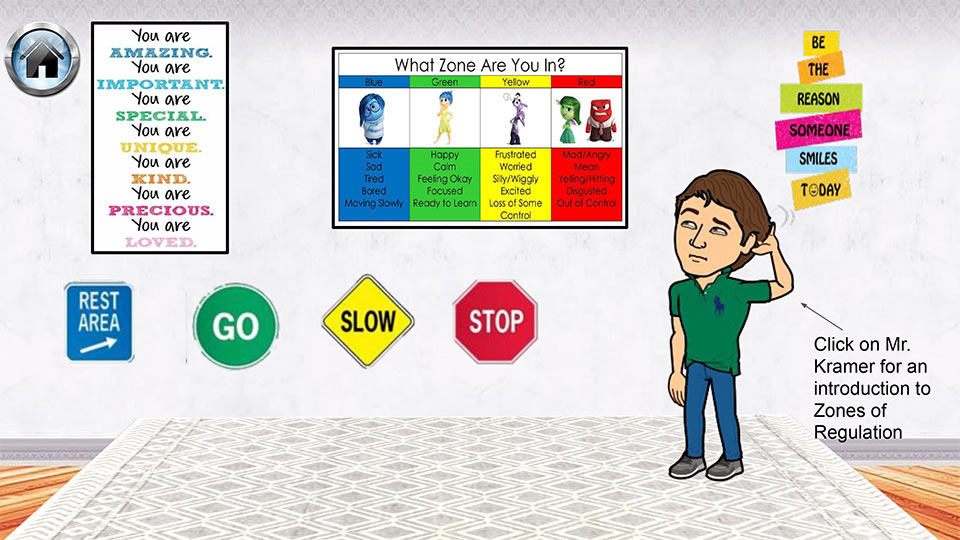As part of our Shared Success series, we offer these "success stories" to spotlight different methods, lessons and creative strategies that NYSUT teachers are using to educate students during a pandemic.
If you told Brockport school counselor Peter Kramer a year ago that he’d be connecting with families through a virtual counseling office — or hosting “talk shows” with his cat Fiona, he never would have believed you.
But after schools suddenly shifted to fully remote learning last March due to COVID-19, the Brockport Teachers Association member knew he had to find a different way to reach his early elementary students.
“I wanted to do something that would make kids feel more connected to the school and hopefully make them laugh,” Kramer said.
That’s when he turned to Fiona, a street cat he adopted when the pandemic began, to help out with a series of videos exploring social-emotional topics. She’s a perfect sidekick as Kramer explains SEL issues like how to control your feelings or the importance of perseverance. She also has a knack for meowing or yawning at just the right time.
“The kids love her,” Kramer said. “They’ll wonder how she shot that rocket at me, or whether she’s really doing math homework.”
Kramer has also expanded his reach by creating a virtual counseling office suite. Inspired by a colleague who showed him a Bitmoji classroom, Kramer has created a virtual counseling world that includes: a calm room (with videos for calming and mindfulness), a Zone of Regulation check-in, a counseling library, family resources, a mailbox for family communication and a lesson room where he posts his weekly instructional videos with Fiona and other staff members.
Kramer, who traditionally pushes in to about two dozen pre-K-1 classrooms at Ginther Elementary with brief mini-lessons, said the virtual counseling set-up and instructional videos have really expanded his contact with families.
“What’s great is that for the first time in my career, I know that parents and guardians are seeing the SEL along with their children," Kramer said. “I’ve tried emails and newsletters in the past to help communicate what we’re doing at school but nothing has come close to the level and understanding I’m now seeing.”
The lessons are clearly sinking in. Families tell him how their child is going around the house singing silly lines from a video or remarking how funny it was to see Fiona on a cellphone. After learning about the Zones of Regulation, students are talking about their feelings in terms of what color zone they are in.

Kramer's virtual "main office" includes a student check-in for the Zones of Regulation.
Kramer noted a number of parents have voiced increasing concerns about how the pandemic is affecting their children’s social-emotional well-being. “There’s a lot more frustration, anxiety and anger,” he said. “With little kids, they can’t put voice to what they’re feeling. They’re shutting down, crying and having more temper tantrums.”
Kramer, a school counselor for 11 years, says it’s natural behavior, especially when children’s routines are out of sync and they’re missing normal social activities and important time with friends and relatives.
Kramer’s had similar conversations about students’ increasing SEL needs with colleagues, which has helped him create timely lessons that tie directly with classroom activities. “I really appreciate all the suggestions and support from faculty and staff,” he said, noting several colleagues (including his kindergarten teacher wife Lindsay) have made guest appearances in his videos. “It all helps build our school community.”
Even once the pandemic is over and schools return to normal scheduling, Kramer expects he will continue his online presence and keep making SEL videos with Fiona. “This works well whether students are learning in-person, hybrid, or fully remote,” he said. “It’s such an effective way to reach all kids at once, build resources and make personal connections with families. It’s actually a positive thing that’s come out of this pandemic.”
Tips for creating video lessons
With or without an animal sidekick, it takes time and patience to create effective instructional videos. Here are some of Kramer’s tips:
- Block off more time than you think you’ll need. With help from his wife Lindsay, a kindergarten teacher at the school, Kramer has found it can take five to seven hours of filming and editing to create a five-minute video. (Of course, getting the cat to do what’s needed can be challenging.)
- Start small and know your “takeaway.” It’s easier to produce smaller chunks and students seem to learn more with bite-sized information.
- Be flexible. If something happens in the moment, go with it. Don’t feel like you have to stick with a script or what’s always been covered. Listen to parents and colleagues for emerging topics.
- Work with colleagues and share resources. Connect what you’re doing with classroom activities.
- Ask for help. Check with tech-savvy colleagues and your technology department to learn more about production and safe online resources.
- Don’t be afraid to make yourself the butt of the joke. Some of Kramer’s colleagues were reluctant to participate because they didn’t want to be embarrassed. “You need to be entertaining and make kids laugh.”